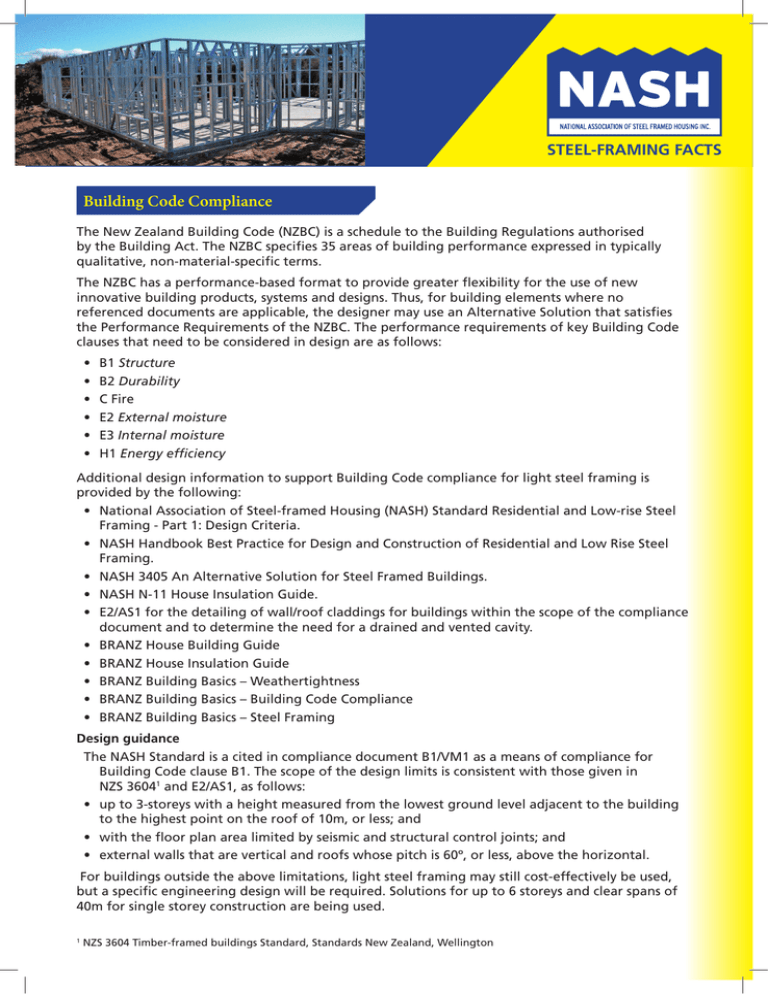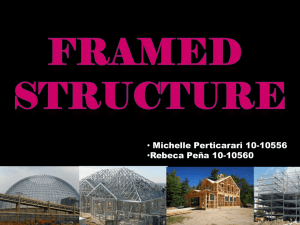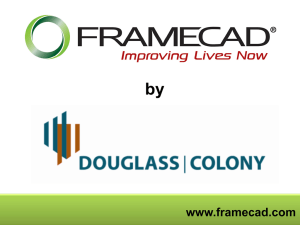Building Code Compliance
advertisement

STEEL-FRAMING FACTS Building Code Compliance The New Zealand Building Code (NZBC) is a schedule to the Building Regulations authorised by the Building Act. The NZBC specifies 35 areas of building performance expressed in typically qualitative, non-material-specific terms. The NZBC has a performance-based format to provide greater flexibility for the use of new innovative building products, systems and designs. Thus, for building elements where no referenced documents are applicable, the designer may use an Alternative Solution that satisfies the Performance Requirements of the NZBC. The performance requirements of key Building Code clauses that need to be considered in design are as follows: •B1 Structure •B2 Durability • C Fire •E2 External moisture •E3 Internal moisture •H1 Energy efficiency Additional design information to support Building Code compliance for light steel framing is provided by the following: • National Association of Steel-framed Housing (NASH) Standard Residential and Low-rise Steel Framing - Part 1: Design Criteria. • NASH Handbook Best Practice for Design and Construction of Residential and Low Rise Steel Framing. • NASH 3405 An Alternative Solution for Steel Framed Buildings. • NASH N-11 House Insulation Guide. • E2/AS1 for the detailing of wall/roof claddings for buildings within the scope of the compliance document and to determine the need for a drained and vented cavity. • BRANZ House Building Guide • BRANZ House Insulation Guide • BRANZ Building Basics – Weathertightness • BRANZ Building Basics – Building Code Compliance • BRANZ Building Basics – Steel Framing Design guidance The NASH Standard is a cited in compliance document B1/VM1 as a means of compliance for Building Code clause B1. The scope of the design limits is consistent with those given in NZS 36041 and E2/AS1, as follows: • up to 3-storeys with a height measured from the lowest ground level adjacent to the building to the highest point on the roof of 10m, or less; and • with the floor plan area limited by seismic and structural control joints; and • external walls that are vertical and roofs whose pitch is 60º, or less, above the horizontal. For buildings outside the above limitations, light steel framing may still cost-effectively be used, but a specific engineering design will be required. Solutions for up to 6 storeys and clear spans of 40m for single storey construction are being used. 1 NZS 3604 Timber-framed buildings Standard, Standards New Zealand, Wellington STEEL-FRAMING FACTS Trade Friendly Speed of Construction Frames and trusses are usually supplied pre-assembled and ready to erect, and some steel-framing fabricators provide a supply and install service. Steel-frames can be lifted by hand or small cranes as they are approximately one-third the weight of timber. The frames come with service holes pre-punched and with plastic grommets to make it easy for sub-trades to work with. Additional service holes are easily drilled or can be cleanly made with a stud punch. Owing to the fact that steel-frames do not absorb moisture, there is no delay waiting for frames to dry. Dimensional Stability The roll-forming technology behind steel-framing gives a high degree of dimensional accuracy, enabling consistently straight walls, square corners and an overall superior finish. The exactness that comes from building in this way helps later trades fitting internal linings, kitchens and other cupboards. As steel is insensitive to moisture changes in a building, frames will not warp, twist, sag or shrink, thereby eliminating many of the maintenance issues that create builder call-backs. Internal Linings Owing to the fact that steel has a similar coefficient of linear thermal expansion1 as gypsum plasterboard2 (11.7×10-6 K compared to16.2×10-6 K), there is a lower risk of cracking. 1 2 NZS 3404.1 Steel Structures Standard, Standards New Zealand, Wellington GIB, http://www.gib.co.nz/assets/Operations-and-Service/Training/DESIGN-ESSENTIALS-FOR-CONTROLLINGMOVEMENT-INDUCED-STRESSES-IN-BUILDING-MATERIALS.pdf, accessed April 2013 www.nashnz.org.nz

